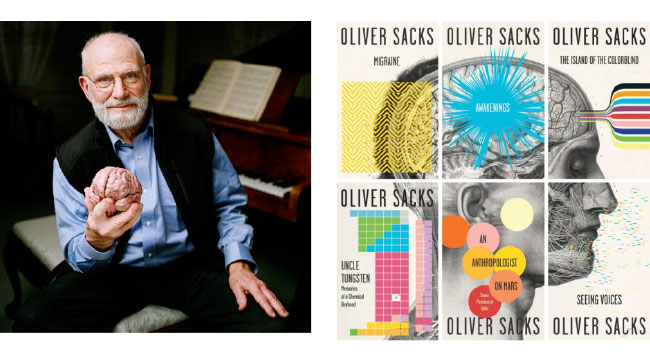Author: Amy Stewart
An important and challenging aspect of being a scientist is communicating information in a way that is both accurate and engaging, and furthermore disseminating the work to a widespread audience. Oliver Sacks is one of the few scientists who has accomplished this with his chosen subject matter, the brain: he skyrocketed to fame in 1973 with his book Awakenings and has remained a household name with his myriad of publications and various film adaptations. Framing a discussion of the scientific backgrounds of neurological conditions within the context of case studies, Sacks ingeniously weaves together humanity and science in his novels, culminating in a thoughtful and compelling read. Written at the midpoint of his authorial career, An Anthropologist on Mars marks a maturation and expansion of the overarching themes in his narratives that he began to explore ten years prior in his most well-known book, The Man Who Mistook His Wife for a Hat. An Anthropologist on Mars details the experiences of seven individuals with neurological disorders ranging from cerebral achromatopsia to Tourette’s syndrome to autism, supplementing descriptions of these disorders, fascinating in their own right, with stories of the manifestation of creativity borne out of these conditions.

Image Caption: Left: Oliver Sacks, author of An Anthropologist on Mars2. Right: Six Oliver Sacks books arranged in a collage, including An Anthropologist on Mars3.
It is clear from the first chapter that An Anthropologist on Mars will not read like a dry, erudite textbook; nor will it be exhibitionist, exploiting its subjects as oddities to be gawked at by onlookers. The novel opens with the story of an elderly man, Mr. I., who has been rendered completely devoid of color vision after a car accident and is seeking Sacks’s help. His sudden loss of color perception, devastating under any circumstance, is made all the more poignant because Mr. I. is a painter. Sacks goes on to recount Mr. I.’s symptoms anecdotally, much more effective than any mere list, and then the methods he used to confer the diagnosis of cerebral achromatopsia. A large portion of the chapter characterizes Mr. I.’s struggle to find pleasure in his daily life and to reconcile his artistic expression in his new sickening and disorienting black-and-white world. Intertwined cleverly within these anecdotes are introductions to the neurological basis of color vision, the history of cerebral achromatopsia, and landmark experiments in the field. The rest of the book follows this same general format, with each chapter a self-contained narrative. Thus, the reader is able to learn about a surgeon with Tourette’s who can perform hours-long surgeries, an artist with an eidetic memory obsessed with painting his childhood town in Italy, a prodigious autistic boy able to draw incredibly detailed sketches of buildings and landscapes from memory, and an autistic professor with a Ph.D. in animal science who feels a connection with animals that she lacks with humans.
Though each story can stand independently, there is an interesting progression from the first to the last chapter. The first few chapters involve individuals whose conditions have been thrust upon them, like by a car accident or a tumor. They have learned not only to adapt to their condition, but to thrive. In fact, the colorless world that Mr. I. first considered so hideous eventually came to be viewed as pure and uncluttered with irrelevant color; he rejects any suggestions of regaining his color vision. His art gains a complexity and depth mirroring his own transformation. This sense of unity between the individual and the disorder is echoed and amplified by the other characters in the book whose conditions are not caused by external factors. Dr. Bennett, the surgeon with Tourette’s, views his disorder as an integral part of his personality. Temple Grandin, the autistic professor said in one of her lectures, “If I could snap my fingers and be nonautistic, I would not – because then I wouldn’t be me. Autism is part of who I am.” Sacks’s writing conveys a deep respect and even admiration for his subjects and their extraordinary abilities. It also provides an immersive experience replete with the struggles and hardships juxtaposed against the resultant beauty and creativity accompanying and sometimes counterintuitive to the various neurological perturbations experienced. In fact, the only flaw in Sacks’s writing is that he at times tends to be too compassionate and empathetic. In the case of the autistic boy, Stephen, who sketched buildings like the Notre Dame, Chrysler Building, and St. Basil’s from memory with painstaking intricacy, he imbues Stephen and his art with emotions and motives that perhaps are just not there, or at the very least, impossible to quantify.
Still, Oliver Sacks’s works continue to be relevant today precisely because of his inclusion of the human element in science. An Anthropologist on Mars will not become antiquated because it relies on background information and underlying questions central to each disorder that will hopefully spur the reader to seek more recent research if interested. There has been a resurgence of science in popular culture that has expanded beyond the written word: there are shows like Through the Wormhole with Morgan Freeman, movies like Interstellar, podcasts like StarTalk by Neil deGrasse Tyson, and an abundance of TED Talks on a wide variety of subjects. Though the medium through which popular science is primarily spread has changed over the decades, it is clear that hard science fields like physics, astronomy, and chemistry, in addition to biology and psychology, thrive in the general public’s eye when given the Oliver Sacks treatment and integrated into a human story, for it is human stories that remain timeless even as their scientific underpinnings are constantly shifting and evolving.
References
- Sacks, O. An Anthropologist on Mars: Seven paradoxical tales. New York: Knopf (1995).
- Sacks_scourfield [Web Photo.] Retrieved from http://www.oliversacks.com/about-oliver-sacks/ (n. d.).
- 6-book cover-collage design. [Web Photo]. Retrieved from http://www.oliversacks.com/books-by-oliver-sacks/anthropologist-mars/ (n. d.).
